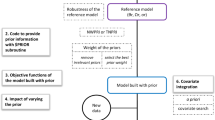Abstract
Purpose. The usefulness of several modelling methods were examined in the development of a population pharmacokinetics model for cefepime.
Methods. The analysis was done in six steps: (1) exploratory data analysis to examine distributions and correlations among covariates, (2) determination of a basic pharmacokinetic model using the NON-MEM program and obtaining Bayesian individual parameter estimates, (3) examination of the distribution of parameter estimates, (4) multiple linear regression (MLR) with case deletion diagnostics, generalized additive modelling (GAM), and tree-based modelling (TBM) for the selection of covariates and revealing structure in the data, (5) final NONMEM modelling to determine the population PK model, and (6) the evaluation of final parameter estimates.
Results. An examination of the distribution of individual clearance (CL) estimates suggested bimodality. Thus, the mixture model feature in NONMEM was used for the separation of subpopulations. MLR and GAM selected creatinine clearance (CRCL) and age, while TBM selected both of these covariates and weight as predictors of CL. The final NONMEM model for CL included only a linear relationship with CRCL. However, two subpopulations were identified that differed in slope and intercept.
Conclusions. The findings suggest that using informative graphical and statistical techniques enhance the understanding of the data structure and lead to an efficient analysis of the data.
Similar content being viewed by others
REFERENCES
Beal SL, Sheiner LB. NONMEM Users Guide, Parts I–VI, Division of Clinical Pharmacology, University of California, San Francisco, 1979–1992.
Barbhaiya RH, Forgue ST, Shyu WC, Papp EA, Pittman KA. High pressure liquid chromatography of BMY-28142 in plasma and urine. Antimicrob. Agents Chemother. 31:55–59 (1987).
Cockroft DW, Gault MH. Prediction of creatinine clearance from serum creatinine. Nephron 16:31–41 (1976).
Dechaux M, Gonzalez G, Broyer M. Creatinine plasmatique, clearance et excretion urinaire de la creatinine chez l'enfant. Arch. Fr. Ped. 35:53–62 (1978).
Maitre PO, Buhrer M, Stanski DR, Thompson D. A three step population pharmacokinetic analysis using NONMEM and bayesian regression: an application to midazolam. J. Pharmacokinet. Biopharm. 19:377–384 (1991).
Mandema JW, Verotta D, Sheiner LB. Building population pharmacodynamic models. I. Models for covariates. J. Pharmacokinet. Biopharm. 20:511–528 (1992).
Davidian M, Gallant AR. Smooth nonparametric maximum likelihood estimation for population pharmacokinetics, with application to quinidine. J. Pharmacokinet. Biopharm. 20:529–556 (1992).
Burtin P, Jacqz-Aigrain E, Girard P, Lenclen R, Magny JF, Betremieux P, Tehiry C, Desplanques L, Mussat P. Population pharmacokinetics of midazolam in neonates. Clin. Pharmacol. Ther. 56:615–625 (1994).
S-PLUS (version 3.1). Seattle, Washington: Statistical Sciences, Inc., 1992.
Shapiro SS, Francia RS. An approximate analysis of variance test for normality. J. Am. Stat. Assoc. 67:215–216 (1972).
Cook RD. Detection of influential observations in linear regression. Technometrics 19:15–18 (1977).
Obenchain RL. Letters to the editor. Technometrics 19:348–351 (1977).
Cook RD, Weisberg S. Criticism and influence analysis in regression. In: Leinhardt S. (ed). Sociological Methodology. San Francisco: Jossey-Bass, 1982, pp 313–316.
Hastie TJ, Tibshirani RJ. Generalized Additive Models. New York: Chapman and Hall, 1990, pp 82–103.
Hastie TJ. Generalized additive models. In: Chambers JM, Hastie TJ., eds. Statistical Models in S. Pacific Grove, California: Wadsworth & Brooks/Cole Advanced Books & Software, 1992, pp 249–307.
Brieman L, Friedman JH, Olshen RA, Stone CJ. Classification and Regression Trees. Belmont, California: Wadsworth International Group, 1984, pp 216–265.
Sheiner LB, Rosenberg B, Marathe VV. Estimation of population characteristics of pharmacokinetic parameters from routine clinical data. J. Pharmacokinet. Biopharm. 5:445–479 (1977).
Drapper NR, Smith H. Applied Regression Analysis. New York: Wiley, 1966, pp 263–304.
Quenouille MH. Notes on bias estimation. Biometrika 43:353–360 (1956).
Miller RG. The jackknife—a review. Biometrika 61:1–15 (1974).
Mosteller F, Tukey JW. Data analysis, including statistics. In: Handbook of Social Psychology Vol 2, Lindzey O, Aronson E, eds. Reading, MA.: Addison-Wesley, 1964, pp 144–145.
Hinkley DV. Jackknife confidence limits using Student approximations. Biometrika 64:21–28 (1977).
Tukey JW. Exploratory Data Analysis. Reading, MA.: Addison-Wesley, 1977.
Barbhaiya RH, Knupp CA, Pittman K. Effects of age and gender on pharmacokinetics of cefepime. Antimicrob. Agents Chemother. 36:1181–1185 (1992).
Barbhaiya RH, Knupp CA, Forgue ST, Matzke GR, Guay RP, Pittman K. Pharmacokinetics of cefepime in subjects with renal insufficiency. Clin. Pharmcol. Ther. 48:268–276 (1990).
Hardin TC, Jennings TS. Cefepime. Pharmacotherapy 14:657–668 (1994).
Rights and permissions
About this article
Cite this article
Ette, E.I., Ludden, T.M. Population Pharmacokinetic Modeling: The Importance of Informative Graphics. Pharm Res 12, 1845–1855 (1995). https://doi.org/10.1023/A:1016215116835
Issue Date:
DOI: https://doi.org/10.1023/A:1016215116835




